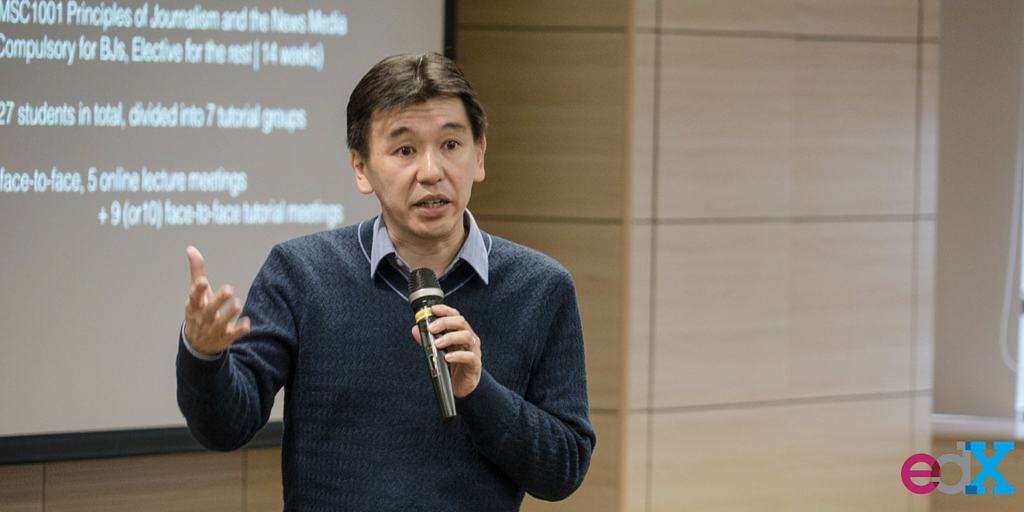The Results of Integrating a MOOC Into On-Campus Teaching
What can MOOCs teach us about how to improve traditional on-campus courses?
Dr. Masato Kajimoto from HKU’s Making Sense of News gave a seminar to teachers on January 14, 2016 about his experience in integrating a MOOC into on-campus teaching. This was originally published on the edX blog.
Producing MOOCs has become a global trend but the big question remains: How can MOOCs bring positive impact to on-campus teaching and learning?
Dr. Masato Kajimoto from the Journalism and Media Studies Centre at the University of Hong Kong (HKU) recently flipped part of his on-campus lectures with materials taken from his MOOC, Making Sense of News. The MOOC was first launched in May 2015, and it was subsequently repurposed to flip five lectures out of thirteen for an on-campus counterpart. The whole experiment was a treasurable data mine and it provided new insights into how MOOCs and on-campus teaching can supplement each other.
The course attracted over 7,500 students from 147 countries in its first run, and it was a prized specimen for researchers, data analysts, and online course developers alike. By studying the dataset, correlations among different student demographics, learning patterns (e.g. clicking and seeking), and performance can all be examined. An interesting finding was that students who performed best in assignments did not have high engagement in forums, probably meaning that they did not require much peer assistance in understanding the contents.
He even incorporated ideas and examples submitted by his MOOC students into his on-campus online teaching materials, facilitating inter-cultural knowledge exchange.
The MOOC was then repurposed into materials for partly flipping an on-campus course at HKU. In the process of repurposing, Dr. Kajimoto beefed up the contents with additional readings and local examples. He even incorporated ideas and examples submitted by his MOOC students into his on-campus online teaching materials, facilitating inter-cultural knowledge exchange. The process was relatively simple, Dr. Kajimoto remarked, because he could easily identify which part of the on-campus course overlaps with the MOOC and plan in advance how to flip the class.
Having a solid script helped Dr. Kajimoto realize how repetitive on-campus lectures are and how time in class can be better spent.
Although producing a MOOC takes more effort than face-to-face (F2F) lecturing, in Dr. Kajimoto’s point of view, the benefits outweigh the costs. As every single word in the videos has to be scripted, having a solid script helped Dr. Kajimoto realize how repetitive on-campus lectures are and how time in class can be better spent. Flipping the lectures also resulted in better engagement in activities and a higher quality of discussion, as students had much more time and motivation to prepare for tutorials. Peer pressure was also a factor because students fear lagging behind their classmates.
Dr. Kajimoto’s observations were backed up by the semester-end student survey, which showed that students enjoyed the blended mode of learning. A student expressed that
“Concepts were easier to understand because of the concise descriptions from the videos.“
Over 76% of learners also indicated that the online lectures enabled them to better manage their study time and facilitated their preparation for the tutorial discussions and exercises. When asked whether they would prefer solely F2F lectures, over 62% disagreed. In Dr. Kajimoto’s own words, it exemplified that “MOOC and on-campus teaching can help each other.”
Making Sense of News re-launched on edX. Join the ride and enroll now!
Tags








Min Lan
“An interesting finding was that students who performed best in assignments did not have high engagement in forums, probably meaning that they did not require much peer assistance in understanding the contents.”
I am kind of disagree with this. First, does the performance on assignment really reflect the learners understanding on the contents? How about the performance-oriented learners rather than master-oriented learners? Second, in terms of high engagement in forums, what are the proofs from online data? How about the validity and reliability? And last, the essence question is what is learning? I watch, I listen, I think, I share and I create, even I did not participate the activities, I can learn from various approaches if that does work on me. As the only social learning approach in MOOC platform, I think the problem is not the participation rate by natural generation. The thing is the design of the activities through discussion forum, both for online and f2f.
Muvaffak GOZAYDIN
Good. Kajimoto . It is really nice to supplement daily college courses by MOOCs. Thanks billion .